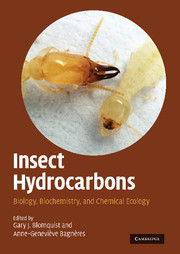Book contents
- Frontmatter
- Contents
- List of contributors
- Foreword
- Acknowledgments
- Part I Chemistry, Biochemistry, and Physiology
- Part II Chemical Communication
- 10 Perception and olfaction of cuticular compounds
- 11 Nestmate recognition in social insects and the role of hydrocarbons
- 12 Cuticular hydrocarbon cues in the formation and maintenance of insect social groups
- 13 Hydrocarbon profiles indicate fertility and dominance status in ant, bee, and wasp colonies
- 14 Chemical deception/mimicry using cuticular hydrocarbons
- 15 Behavioral and evolutionary roles of cuticular hydrocarbons in Diptera
- 16 Contact recognition pheromones in spiders and scorpions
- 17 Hydrocarbons as contact pheromones of longhorned beetles (Coleoptera: Cerambycidae)
- 18 Polyene hydrocarbons, epoxides, and related compounds as components of lepidopteran pheromone blends
- 19 Volatile hydrocarbon pheromones from beetles
- 20 Future directions in hydrocarbon research
- Index
14 - Chemical deception/mimicry using cuticular hydrocarbons
from Part II - Chemical Communication
Published online by Cambridge University Press: 18 May 2010
- Frontmatter
- Contents
- List of contributors
- Foreword
- Acknowledgments
- Part I Chemistry, Biochemistry, and Physiology
- Part II Chemical Communication
- 10 Perception and olfaction of cuticular compounds
- 11 Nestmate recognition in social insects and the role of hydrocarbons
- 12 Cuticular hydrocarbon cues in the formation and maintenance of insect social groups
- 13 Hydrocarbon profiles indicate fertility and dominance status in ant, bee, and wasp colonies
- 14 Chemical deception/mimicry using cuticular hydrocarbons
- 15 Behavioral and evolutionary roles of cuticular hydrocarbons in Diptera
- 16 Contact recognition pheromones in spiders and scorpions
- 17 Hydrocarbons as contact pheromones of longhorned beetles (Coleoptera: Cerambycidae)
- 18 Polyene hydrocarbons, epoxides, and related compounds as components of lepidopteran pheromone blends
- 19 Volatile hydrocarbon pheromones from beetles
- 20 Future directions in hydrocarbon research
- Index
Summary
Chemical deception/mimicry is one of the most amazing phenomena in the field of chemical ecology. It involves a mimicry complex in which multiple living protagonists, i.e., the model, the mime and the dupe (signal receiver), interact at several biochemical and physiological levels. Mimicry complexes have evolved, sometime over thousands of years, throughout the animal and plant kingdoms, and encompass a wide range of organisms from mosses to vertebrates. Chemical deception/mimicry can take many different forms: camoufl age, mimesis, crypsis, transparency, and usurpation.
In behavioral ecology, various theories have been proposed to explain inter-individual signaling communication activities, e.g. Dawkins versus Tinbergen (Dawkins and Krebs, 1978; see also Hughes, 2008). Chemical deception/mimicry is generally considered to be a form of co-evolution, i.e., different from convergent evolution, which can be defined in terms of either an arms race when it is used aggressively, or as “reciprocal altruism” or mutualism when it is cobeneficial (e.g. between the bumblebee and orchid). Mimicry processes are usually classified according to function with a basic distinction being made between defensive and aggressive mimicry, while others distinguish between Batesian mimicry, i.e. a deceptive strategy in which a harmless mimic poses as harmful, and Mülerian mimicry, i.e. a nondeceptive strategy in which two harmful species share similar perceived characteristics. In his review, Pasteur (1982) classified mimicry processes into several categories including camoufl age in order to escape predators or surprise preys (homochromy), imitation of natural elements or plant organs (homotypy), and temporary or permanent mimicry.
- Type
- Chapter
- Information
- Insect HydrocarbonsBiology, Biochemistry, and Chemical Ecology, pp. 282 - 324Publisher: Cambridge University PressPrint publication year: 2010
- 38
- Cited by



